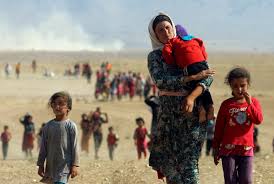More than a decade after the Islamic State’s genocidal assault on Iraq’s Yazidi community, justice remains out of reach for thousands of survivors. A new report by the Syria Justice and Accountability Centre (SJAC) warns that efforts to locate the over 2,800 Yazidis still missing—many believed to be in Syria—are being undermined by institutional neglect, lack of coordination, and the absence of political will.
The report highlights the devastating legacy of the 2014 Sinjar massacre, when ISIS abducted thousands of Yazidi men, women, and children. Although some survivors have been rescued and mass graves unearthed in Sinjar, the fate of many remains unknown.
A Stalled Search, a Nation in Limbo
SJAC’s findings paint a bleak picture. Families have been denied answers about the fate of their loved ones, leaving them unable to resolve basic legal matters such as inheritance or remarriage. Yazidi civil society groups—working tirelessly to trace the missing—are hampered by limited access, opaque regional governance, and the absence of a unified list of missing persons.
“This is not just about the missing,” the report notes. “It is about a community caught in limbo—psychologically, legally, and politically.”
Syria: The Likely Epicenter
According to the report, many of the missing Yazidis are believed to be in Syria, where ISIS operated detention and trafficking networks between 2014 and 2019. The SJAC’s year-long investigation used survivor testimonies and forensic data to reconstruct the movements and likely fates of Yazidi captives across three distinct phases of captivity:
- Raqqa (2014–2016): In the early years, captives were held in urban areas like Raqqa, where many died from torture, suicide, or executions. Bodies were likely buried in informal graves or official cemeteries.
- Deir Ezzor (2017–Early 2019): As ISIS retreated, Yazidis were trafficked to Deir Ezzor. Coalition airstrikes and artillery fire caused mass casualties, with remains often left under rubble or buried hastily.
- Baghouz and Aftermath (Early 2019–Present): In ISIS’s final enclave, Baghouz, captives suffered severe overcrowding and lack of food. Many perished during the final battle or its aftermath and were buried in unmarked, temporary graves.
A Unique Forensic Challenge
What sets the Yazidi disappearances apart is that most women and children were not held in formal prisons but in private homes or compounds, making standard search methods difficult. SJAC’s methodology, which combines big data analysis with contextual mapping of detention and burial sites, required adaptation to these less formal, dispersed holding areas.
Working with partners such as the Syrian Missing Persons and Forensic Team (SMFT) in Raqqa and Guatemala’s Foundation of Forensic Anthropology (FAFG), the SJAC is using forensic tools and DNA sampling to link testimonies with grave sites and facilitate exhumations.
What Comes Next
Despite the grim findings, the report remains cautiously optimistic. It outlines a path forward, calling for:
- Improved coordination between Iraqi and Syrian authorities;
- Cross-border collaboration to enable DNA matching and legal repatriation;
- Greater transparency from local governance bodies;
- Targeted forensic operations in northeast Syria where gravesites have been identified.
The SJAC concludes that resolving the fate of the missing is not just a humanitarian imperative but a cornerstone for justice, accountability, and post-ISIS reconciliation.
“This is about more than bones and names,” the report says. “It’s about rebuilding trust, identity, and justice—for Yazidis, and for Syria as a whole.”


